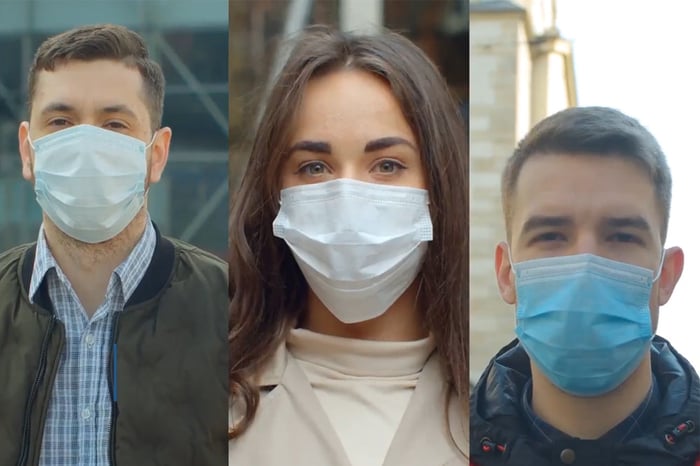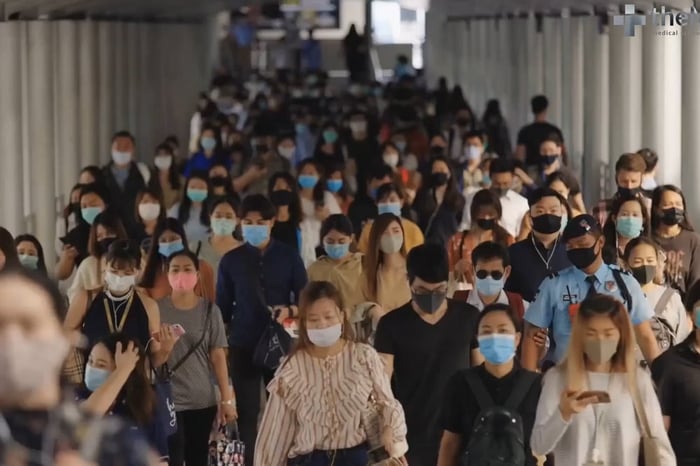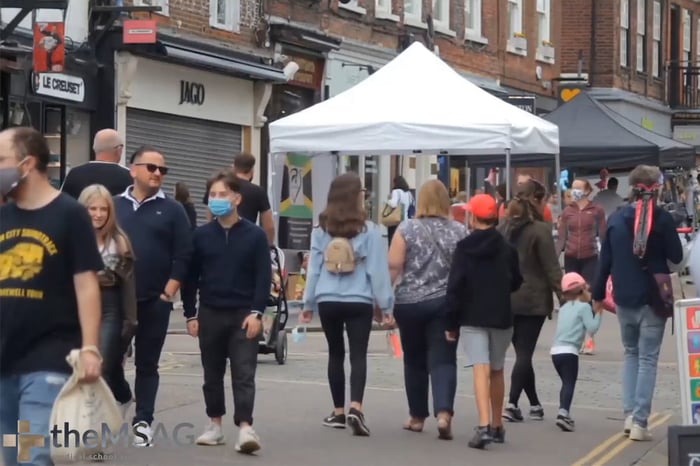
COVID-19 - Introduction
In this blog, we will discuss the essential information you need to understand:
- Pathogens, pandemics and names used to refer to the virus and the disease
- What is COVID-19 and how it affects individuals
- COVID-19 testing
- Potential solutions to manage COVID-19
Let’s get started with some key definitions to help us understand viruses and pandemics!
The Basics
What is a pathogen?
A pathogen is an organism that can invade a host or a body and can cause disease. But not all microorganisms are pathogens. The vast majority of microorganisms around us are totally harmless to humans.
Obligate vs Facultative pathogens
Something useful to think of when you try to remember all the various pathogens is the distinction between obligate pathogens and facultative pathogens.
Obligate pathogens must (or are obligated to) reproduce inside a host, because they need a host for their normal life cycle. A very good example is viruses. They can only reproduce by using the cellular machinery inside a host.
Facultative pathogens, on the other hand, are the vast majority of bacteria and fungi that you may see in the environment. They do not need a host to reproduce or for their normal life cycle. But they have the ability sometimes to invade a host, and when they do so, they can cause disease.
Pandemic, Epidemic, Endemic - What’s the difference?
Endemic
If someone said that Malaria is endemic in Sub-saharan Africa, what do you think that means? It means that Malaria has a persistent expected level of presence in Sub-saharan Africa. “Endemic” refers to the level of persistent presence of a condition, virus or organism in a particular area.
Epidemic
An epidemic is an outbreak. It is referring to how many more new cases you see: the growth and the rise in numbers. The Oxford Languages definition is: a widespread occurrence of an infectious disease in a community at a particular time.
Pandemic
A pandemic is an epidemic - a growth, or outbreak - that spans multiple countries and multiple continents. An easy way to remember this is to think of P as in “passport”, which you use to travel to multiple countries or continents.
The R Number
The “R” number is a way of measuring the spread of a disease. It is often referred to as above 1 or below 1. If the R number is above 1, that means that 1 infected person is going to infect more than one new person on average. In other words, it means that the outbreak is still growing. More new people will become infected than the current number of infected people.
If the R number is below 1, that means that, on average, the number of new people getting infected is less than the number of current people who have the infection. That also means that the epidemic, or pandemic in the case of COVID-19, is shrinking.
How is the R number measured?
The R number isn’t actually measured, but it is calculated. Epidemiologists run complex models to estimate the R number, using recorded data such as:
- How long someone is infectious for
- The mortality rate
- The number of hospital admissions
- The new number of cases
It also takes into account how much people are meeting or the opportunities for contact as well as the mode of transmission of the condition.
It is helpful to remember that it is estimated, and that this estimation uses past data to make predictions about the current or the future R number. Both of these elements can add inaccuracies or uncertainty around the R number.
COVID? CORONAVIRUS? NAMES YOU SHOULD KNOW.
We are sure that you have heard lots of different terms being used during this pandemic so let’s break them down.
Coronaviruses are a family of viruses that cause illness in humans and animals. They cause respiratory or lung infections that can range from mild colds to deadly disease. In fact, coronaviruses cause about one-quarter of all common colds.
However, sometimes coronaviruses can be deadly, like the 2003 epidemic of SARS in Asia. SARS stands for Severe Acute Respiratory Syndrome. The "SARS-Coronavirus" (SARS-CoV) was the virus responsible for the 2003 epidemic. As of 2020, SARS-Coronavirus is considered to be eradicated in humans. A virus similar to SARS-CoV, was discovered in December 2019 called SARS-CoV-2. This is the pathogen that caused the COVID-19 pandemic.
So is it called SARS-COV-2 or COVID-19?
They are actually the name of two different things; the virus and the disease. For example, HIV is the virus that causes the disease AIDS, and SARS-COV-2 is the virus that causes the disease called COVID-19.
How are viruses and diseases named?
Viruses are named by the International Committee on Taxonomy of Viruses based on their genetic structure. This makes it easier for the scientific community to work on diagnostic tests, vaccines and medicines.
Diseases are officially named by the World Health Organization. The WHO have their own guidelines to decide how to best name a condition, but generally they want to avoid confusion. The reason COVID-19 is NOT called “SARS 2” is because it would create a lot of confusion for people who still remember the 2003 SARS epidemic.
What is COVID-19? Why is it dangerous?
COVID-19 is an infectious respiratory disease that mainly affects the lungs. The symptoms are nonspecific, which means that it is hard for doctors to know if someone has COVID-19 just based on their symptoms. A lot of the symptoms are similar to things like the common cold, which can create challenges for doctors. This is why testing is so important.
According to the NHS website, the three main symptoms are:
- A high temperature
- A new continuous cough
- Or a loss or change in sense of smell or taste
In most other reputable sources such as the mayo clinic, the World Health Organisation or webMD, the most common symptoms are listed as Fever, Cough and Tiredness. The loss of taste or smell is also prevalent and is recognised by some to be an early symptom.
The Incubation Period
An incubation period is the amount of time between infection and the appearance of the first symptoms. According to the WHO, the time from COVID-19 exposure to the moment when symptoms begin is, on average, 5-6 days - but can range anywhere from 1-14 days. This is why people who have been exposed to the virus are advised to remain at home and stay away from others for 14 days even if they have no symptoms. This helps to prevent the spread of the virus, especially where testing is not easily available.
The incubation period is important when discussing the handling of the pandemic in the interview. For example, if you are asked the question “do you think making people self-isolate for 14 days is too long? Should the government have asked for 7 days of isolation like some other European countries did?” what would you say? When thinking about your answer, something good to start with would be to show your understanding about why the UK government chose 14 days initially (the incubation period of the virus).
You should also show understanding that because of the incubation period, people can transmit the virus before they develop symptoms. This is important as it means longer incubation times can be dangerous, increasing the spread.
Transmission
Aside from the incubation period, the method of transmission from one person to another also has a high impact on the virus’ overall rate of spread.
COVID-19 is spread through liquid particles produced by an infected person. These particles are present in theirmouth or nose. Imagine when someone coughs, sneezes, speaks, sings or even breathes heavily, these liquid particles are dispersed into the air, and can easily travel from the infected person to a new person.
You may have heard the terms “respiratory droplets” or “aerosols”. These words describe the liquid particles I just mentioned, and the categorisation is based on the size of the liquid particle. If the particle is larger, it is referred to as a respiratory droplet, and the smaller liquid particles are called aerosols.
With that in mind, there are 3 main ways that respiratory viruses can be transmitted.
- Contact transmission - when someone comes into direct contact with an infected person or touches a surface that has been contaminated.
- Droplet transmission - transmission of both large and small respiratory droplets that contain the virus, which would occur when near an infected person.
- Airborne transmission - smaller droplets and particles that are suspended in the air over longer distances and time than droplet transmission.
For a little while when the pandemic started, everyone was very worried about surface contact transmission. Remember the shops in your neighbourhood being sold out of all disinfectant products? However, recent research has shown that although SARS-CoV-2 can persist for days on some surfaces, this was unlikely to be a major route of transmission.
According to the World Health Organisation, most of the transmission occurs through respiratory droplets. These can get into another person’s mouth, nose, or eyes when people are close to each other or in direct contact. Remember, it is not only coughing or sneezing; respiratory droplets travel through just breathing as well. It is understanding this that has led to the widespread worldwide recommendations on social distancing, but there is clear disagreement on what the “right” or “safe” distance is. While the WHO recommends 1 metre of distancing, the NHS, CDC and other official bodies recommend 2 metres.
This has led to the development of many more public health policies, such as the closure of public indoor spaces: restaurants, choir practices, fitness classes, nightclubs, offices or places of worship.
Whether the transmission is via respiratory droplets or airborne, it is clear that transmission is reduced outside. In places where cold weather is here or coming, socialising outside may be a challenge and this, in turn, can increase transmission rates of the virus.
Now that we know how COVID-19 is spread, we need to think about how we can prevent its transmission. At medical school you will learn about how to reduce the spread of infections, and a lot of this applies to COVID-19. One of the best things that we can do to prevent the spread of COVID-19 is to wash our hands properly. It is also important to cover your nose and mouth when sneezing, coughing and breathing. The World Health Organisation recommends that you wear a mask and keep a distance of at least 1 metre when around other people, as well as avoiding crowds or groups.
COVID-19 Testing
Earlier we talked about how important testing is for COVID-19 because the symptoms are nonspecific. Early recognition is key to preventing transmission. Let’s now make sure that you understand the types of tests that exist, what they test and the difference between each of them. A COVID-19 test can be called many things - have you heard of the following?
- PCR test
- Nucleic acid amplification test
- Viral test
- Molecular test
- Diagnostic test
- Serological test
- LAMP test
The many names of the COVID-19 test and the misinformation you find online can all contribute to being not too sure about what a COVID-19 test actually is.
COVID-19 tests can be looked at as 2 main types: a diagnostic test OR an antibody test. Within the category of diagnostic tests, there are 2 kinds, molecular and antigen. Let’s look at these a little more closely.
Diagnostic tests
Diagnostic tests are used when we want to find out if somebody has COVID-19 right now. We’re not looking to find out if they’ve had it previously. If we want to find out if they have it currently, there are two main things that we can measure. One option is to look for the virus itself - or more specifically, look for the genetic material of the virus. The second option is to look for a protein or antigen that is made by the virus.
This is what creates the two categories of diagnostic tests. If you are looking for an antigen or protein made by the virus, then it is called an antigen test. If you are looking for the genetic material of the virus then it is called a molecular test.
Diagnostic subtest - Molecular test
When it comes to the molecular diagnostic test of COVID-19, there are yet, many more names that it can be called:
- Viral test.
- Nucleic Acid Amplification Test.
- A third alternative is to call it the name of the laboratory method used to detect the genetic material. There are 2 main laboratory methods used to detect the genetic material: PCR (polymerase chain reaction) and LAMP (Loop-mediated Isothermal Amplification).
There is one more term that is commonly used to refer to this molecular diagnostic test: RT-PCR. We’ve just mentioned PCR is a lab method. So what is RT?
The PCR laboratory method can only detect DNA. The coronavirus is an RNA virus, so it requires an extra step to be able to be diagnosed with PCR. First, the RNA needs to be made into DNA, and then the PCR test can measure whether it’s present or not.
The step that makes RNA into DNA uses an enzyme called Reverse Transcriptase, or RT.
PCR and RT-PCR are not the same thing. PCR works on DNA. RT-PCR is PCR, but with an extra step first that makes the RNA into DNA. However, when you see PCR test or RT-PCR test in the context of a COVID-19 diagnostic test, they are referring to the same test.
Diagnostic subtest - Antigen test
There isn’t much to explain about the Antigen test other than we’re not detecting the genetic material, but instead, we are detecting an antigen, made by the virus.
Serological Test
There is one more type of testing for COVID, and that is the serological test. It is also know as:
- An immunity test
- An antibody test
- A serology test
- A blood test
This test requires a blood sample, not a swab. Serological testing differs from the diagnostic tests discussed above. Diagnostic tests are analysing if somebody currently has the virus, whereas a serological test is checking to see if somebody has had COVID-19 before, and has mounted an immune response to COVID-19. It doesn’t give you information about the current status of COVID-19 infection of the individual who takes the test.
What happens to people that get COVID-19?
Let’s think about how COVID-19 affects supportivecom people around us. It is more likely that an interview question on COVID-19 asks for your opinion on its impact, rather than pure scientific facts.
Around 80% of people who get COVID-19 recover from it without needing any hospital treatment. Some people are asymptomatic, which means that they could have had COVID-19 and never know because they had no symptoms at all. Around 15% of people become seriously ill and require supportive treatment such as oxygen therapy. Around 5% of people become critically unwell and need intense care. Complications of COVID-19 include respiratory or lung failure, blood clots, heart attacks, and in the worst cases death.
Who is most at risk of more severe illness from COVID-19?
COVID-19 can be serious in anyone, but there are certain groups who are more at risk of severe illness. As you may have heard in the news, COVID-19 is often much more serious in people over 60 years old. Some other groups are at risk of severe illness too. This includes people with underlying medical problems such as high blood pressure, heart/lung disease, diabetes, obesity, and cancer. It also includes individuals who are immunosuppressed, either because of a medical condition or because they may be taking immunosuppressant drugs for a medical condition (after a transplant for instance).
When we think about COVID-19, we often think about the short-term consequences. Most people recover quickly from COVID-19, typicallywithin a couple of weeks. However, the effects of COVID-19 can last for weeks or even months in some people. This has been called ‘long COVID’. The symptoms of ‘long COVID’ include tiredness, breathlessness, depression, chest pain, and ‘brain fog’.
Possible solutions for COVID-19
Treatments
At the time of preparing this lesson, there is currently NO cure for COVID-19. You CANNOT use antibiotics, as this is a viral infection and not a bacterial infection. Antibiotics cannot be used for viruses. Even though there is no cure, we do have things that we can do as doctors to help patients.
A lot of the treatment is supportive. This means that it aims to provide symptom relief. This might include interventions such as oxygen therapy, fluids, and ventilation. There is good evidence that steroid treatment helps to reduce mortality for COVID-19. The steroid that has been found to be effective is called dexamethasone.
If patients become very unwell with COVID-19 then they often require to be moved to an intensive care unit. In intensive care, they get more support, which often includes ventilation. A ventilator is a machine that helps you breathe by mechanically pumping oxygen into your body.
Vaccines
Definition and Herd Immunity
Now let’s discuss the main exit strategy from this pandemic - vaccines. The progress on vaccines is changing all the time so make sure that you are up to date with the latest information. Before we discuss recent COVID-19 vaccine announcements, let’s make sure you remember what vaccines are and what herd immunity is.
Vaccines are made of the viruses, or components of the viruses that you are trying to protect yourself from. Take a measles vaccine for example. The measle vaccine has the measle virus in it. Those viruses have been either killed before they’re put into vaccines or they have been seriously weakened so that the vaccine does not make you sick.
The idea is that, if you take a vaccine that has a weakened or killed virus, or an element of the virus in it, your body will react and mount an immune response by creating antibodies. These antibodies are stored within your body so that when you actually catch the virus unwantedly, your body is ready to respond and fight it better.
Herd immunity is a concept by which we say that a population can be protected from a disease or a condition if enough members of that population are vaccinated, or have antibodies against that disease.
The number of people in a population that need to have antibodies in order to provide herd immunity differs from one condition to another. For example, for a population to be protected against measles, you need 95% of the population to have antibodies.In comparison for polio, if 80% of the population had antibodies, then the population would be considered protected against polio and have herd immunity.
COVID-19 Vaccine Progress
As of December 2020, there were 57 vaccines for COVID-19 in clinical trials. The three most promising vaccines at that time were from:
- Pfizer/BioNTech
- Moderna
- Oxford/AstraZeneca
The reason why these three vaccines are the most promising is that they have all shown positive results from interim analysis of their Phase III vaccine trials. At the beginning of December 2020, the UK became the first western country in the world to approve a COVID-19 vaccine - the vaccine made by Pfizer/BioNTech. It has been shown to be 95% effective in trials. In total, the UK government has secured early access to around 350 million vaccine doses with six separate vaccine developers. By January of 2021, all three of the above vaccines have been approved for use in the UK.
The World Health Organization
Arguably the most important global organisation in this pandemic is the World Health Organization (WHO). The World Health Organization is a specialised branch of the United Nations which is responsible for global public health. The WHO has lots of functions but during this pandemic its most important functions are helping countries prepare and respond to COVID-19. They did this by providing accurate information, and coordinating the “Solidarity Trial” to help find medicines for COVID-19.
Conclusion
In your medical interviews you should be able to demonstrate a good understanding of the basic science principles related to COVID-19. Being able to discuss the topics mentioned in this post will demonstrate that you have a genuine interest in medical issues and that you keep upto date with the latest information. These are both important traits for an aspiring doctor. Take some time to ensure you understand the key definitions discussed here and keep reviewing reliable sources to ensure your knowledge remains current. The best way to gain confidence in answering hot topic questions is to practice under interview conditions. With theMSAG you can undertake online mock panel interviews and mock MMI circuits. The questions are personalised to each applicant and detailed feedback is provided for students to help them improve and achieve interview success.



